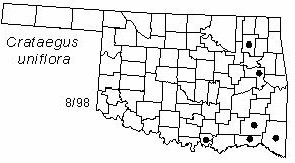Small shrub, low-growing with spreading branches, may reach 4 m (12 ft) in height. Twigs red-brown, turning to gray with age, densely pubescent, with slender spines 1-6 cm (0.4-2.4 in) long. Leaves alternate,simple, obovate, elliptic or ovate with sunken veins, 1-6 cm (0.4-2.4 in) long and 0.7-3.2 cm (0.3-1.3 in) wide, upper surface with scattered hairs to glabrous, lower surface pubescent,upper surface dark green and lustrous, paler beneath, leaves almost sessile, cuneate at base, serrate with tiny black glands. Flowers solitary on short tomentose pedicels, 10-15 mm (0.4-0.6 in) long, greenish to dull red, large and hairy with glandular serrate margins; petals 5, white; styles 5-7; stamens 20, white or pale yellow; flowers appear April to May. Fruits pomes, 7-12 mm (0.5 in) diameter, subglobose with persistent calyx, pubescent, green-yellow to dull red; nutlets 3-5, dorsally grooved, matures in October.
Distribution: occurs from New York south to Florida and west to Texas. Uncommon in Oklahoma.
Habitat: dry woodlands, rocky uplands and open fields.
Comments: Crataegus is from the Greek meaning "flowering thorn"; uniflora refers to the single flower.
Field identification: dwarf hawthorn can be readily distinguished from other hawthorn species by its small stature and single flower/fruit.
Wildlife benefits: In general, the fruits of hawthorn species are eaten by several species of birds. The dense branching patterns supply shelter.
NWI status: none
Distribution in Oklahoma: 
BACK
NEXT
RETURN TO INDEX
Last update: 9/9/99
 Go to Oklahoma Biological Survey Home Page
Go to Oklahoma Biological Survey Home Page
 Disclaimer
Disclaimer